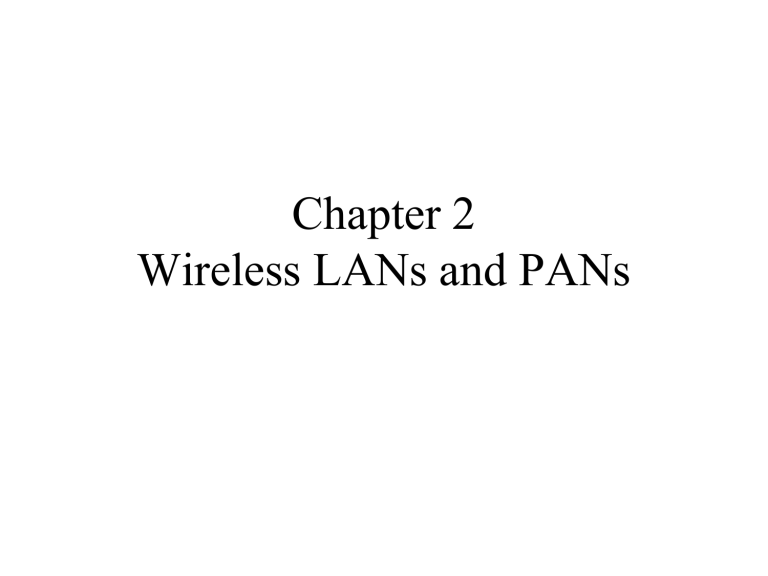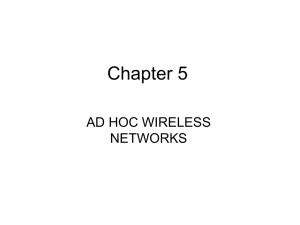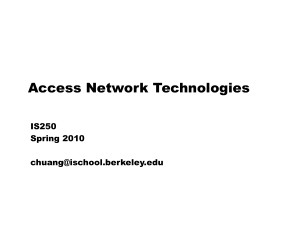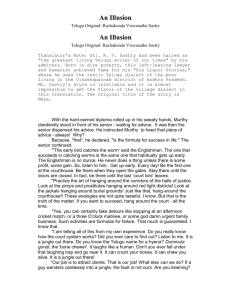Chapter 2 Wireless LANs and PANs

Chapter 2
Wireless LANs and PANs
2.1 Introduction
• Fundamentals of WLANs
• IEEE 802.11
• HIPERLAN
• Bluetooth
• HomeRF
2.2 Fundamentals of WLANs
• Difference between wireless and wired
– Address is not equivalent to physical location
– Dynamic topology and restricted connectivity
– Medium boundaries are not well-defined
– Error-prone medium
• Use of WLANs
– Surf Internet on the move
– Areas without infrastructure, or affected by earthquakes or disasters
WLANs can be set up on the fly
– Historic buildings may not be wiring
• Design Goals
– Operational simplicity
– Power-efficient operation
– License-free operation
– Tolerance to interference
– Global usability
– Security
– Safety requirements
– Quality of service requirement
– Compatibility with other technologies and applicatoins
2.2.2 Network Architecture
• Infrastructure Based vs. Ad Hoc LANs
– Infrastructure: access points (APs) and mobile stations
(STAs)
– Ad hoc LANs: do not need fixed infrastructure
• Components in IEEE 802.11 network
– BSA: coverage of an AP
– BSS
– DS
– ESS
– Figure 2.1
本圖取自 "Ad Hoc Wireless Networks", by C. Siva Ram Murthy and B. S. Manoj, published by Prentice Hall, 2004
• Service offered by IEEE 802.11 network
– Association
– Reassociation
– Diassociation
– Distribution: routing
– Integration: if send frames through non-802.11
– Authentication
– Deauthentication
– Privacy
– Data delivery
2.3 IEEE 802.11
• Physical Layer
– Physical medium dependent sublayer (PMD)
– Physical layer convergence protocol (PLCP)
• Abstracts functionality for MAC
• Offers service access point (SAP): 1 or 2Mbps
• Clear channel assessment (CCA): CSMA/CA
– 3 choices:
• FHSS: GFSK and 4-level GFSK
• DSFF: DBPSK and DQPSK
• Infrare: PPM
2.3.2 Basic MAC Layer
Mechanisms
• Distributed Foundation Wireless Medium Access
Control (DFWMAC)
– Distributed coordination function (DCF)
– CSMA/CA
– To avoid hidden terminal, RTS/CTS
– Point coordination function (PCF): real time services
– Inter-Frame Spacing (IFS)
• SIFS
• PIFS
• DIFS
• EIFS
2.3.3 CSMA/CA Mechanism
• CSMA/CD is not applicable
• Fig 2.2 IEEE 802.11 DCF and RTS-CTS
• If medium is busy, node backs off , in which station defers channel access by a random time chosen within contention window (CW)
• As backoff counter reaches zero, station can access medium
• During backoff, if busy channel, freeze backoff counter; resume once channel becomes idle
• CW size
– Unnecessary delay if too large
– Collision probability increase if too small
– Binary exponential backoff technique is used
Fig. 2.2
本圖取自 "Ad Hoc Wireless Networks", by C. Siva Ram Murthy and B. S. Manoj, published by Prentice Hall, 2004
Overhead involved in RTS-CTS
• Non-negligible overhead
• If frame size > RTS_threshold, RTS-CTS is activated, a four-way handshake (I.e. RTS-
CTS-DATA-ACK)
• If frame size < RTS_threshold, a two-way handshake (DATA-ACK)
Fig 2.3 MAC as a state machine
本圖取自 "Ad Hoc Wireless Networks", by C. Siva Ram Murthy and B. S. Manoj, published by Prentice Hall, 2004
Fragmentation
• Decreasing frame error rate use shorter frames
split user data packet into fragments
• RTS/CTS carry duration for current fragment and estimated time for next fragment
• Medium reserved for successive frames
2.3.4 Other MAC Layer
Functionalities
• Point Coordination Function
– Guarantee on maximum access delay, minimum transmission bandwidth and other QoS
– Centralized scheme, applicable only in networks where AP (Point Coordinator) pool nodes
– Superframe: contention free periods(CFP)+contention period(CP)
Synchronization
• Timing synchronization function (TSF)
• Required for
– Power management
– PCF coordination
– Frequency hopping spread spectrum (FHSS) hopping sequence synchronization
• Within a BSS
– Quasi periodic beacon frames transmitted by AP
– Contains time-stamp for adjusting clock
– Contains information for power optimization and roaming
Power Management
• Always ready to receive consume more power (as high as 100 mA)
• Must be switched off whenever carrier sensing is not needed
• 2 states: sleep and awake
– Longer periods in sleep leads to low throughput
– Shorter periods in sleep leads to high power consumption
Roaming
• Provide uninterrupted service when walk around with a wireless station
• When poor quality of current link, start scanning for another AP
– Active scanning: send a probe on each channel and wait for response
– Passive scanning: listen medium to find other networks
2.3.5 Other Issues
• Newer standards
– 802.11a/11b/g
– Trademark by Wireless Ethernet Compatibility
Alliance (WECA) as Wi-Fi
– 802.11e: time-sensitive applications, voice/video
– 802.11f: inter-AP communication to handle roaming
– 802.11i: advanced encryption for better privacy
QoS for Voice and Video Packets
• Delay-sensitive packets: higher priority
– Hybrid coordination function (HCF): AP polls stations in a weighted way to offer QoS
– Extended DCF: higher priority stations choose random back-off interval from a smaller CW.
Wired Equivalent Privacy (WEP)
• Data integrity
• Access control
• Confidentiality
• Vulnerable if more sophisticated mechanisms are used to crack the key
2.5 Bluetooth
• Logically partitioned into 3 layers:
– Transport protocol group
• Radio layer
• Baseband layer
• Link manager layer
• Logical link control
• Adaptation layer
• Host controller interface
– Middleware protocol group
• RFCOMM, SDP, IrDA
– Application group
• Application profiles
Fig 2.7 Bluetooth protocol stack
本圖取自 "Ad Hoc Wireless Networks", by C. Siva Ram Murthy and B. S. Manoj, published by Prentice Hall, 2004
Radio (Physical) Layer
• GFSK
• 64Kbps voice channels and asynchronous data channels with peak rate of 1Mbps
• Data channel: asymmetric or symmetric
• 79 channels, 79 hops
• Typical link range: up to 10 m, can be extended to 100m by increasing power
Baseband Layer
• Piconet (Fig 2.8)
• 48-bit address
本圖取自 "Ad Hoc Wireless Networks", by C. Siva Ram Murthy and B. S. Manoj, published by Prentice Hall, 2004
Piconet
• Master + up to 7 active slaves
Fig 2.9 Operational States
本圖取自 "Ad Hoc Wireless Networks", by C. Siva Ram Murthy and B. S. Manoj, published by Prentice Hall, 2004
Fig 2.10 Transmission over a channel
• ACL: asynchronous connectionless link
• SCO: synchronous connection oriented link
本圖取自 "Ad Hoc Wireless Networks", by C. Siva Ram Murthy and B. S. Manoj, published by Prentice Hall, 2004
Inquiry State
• A potential master sends inquiry packet on inquiry hop sequence of frequencies
• A slave periodically enter inquiry scan state and listen for inquiry packets
• When received, send response packet containing hopping sequence and device address
Page State
• Master estimate slave’s clock to determine hop sequence, and send page message
• Slaves listen in page scan mode
• On receiving page message, slave enter page response sub-state, send page response containing its device access code (DAC)
• Master enter page response state (after receiving slave’s response), inform slaves its clock and address for determining hopping sequence and synchronization
Scatternets and Issues
• Piconet may overlap both spatially and temporally
• Each piconet is characterized by a unique master and hop independently
• As more piconets added, more probability of collisions
• Device can participate in 2 or more piconets by time sharing (as a slave in several piconets, but as a master in only a single piconet)
• A group of piconets scatternet (Fig2.11)
本圖取自 "Ad Hoc Wireless Networks", by C. Siva Ram Murthy and B. S. Manoj, published by Prentice Hall, 2004
• Issues:
– Gateway nodes: bound back-and-forth, hard to achieve full utilization
– Timing may miss:
Link Manager Protocol
• Power Management
– Active mode: active slaves are polled by master
– Sniff mode: master issues a command to slave to enter sniff mode
– Hold mode: temporarily not support ACL packets, performing scanning, paging, inquiring, or attending another piconet
– Park mode: slave gives up its active member adress
• Security Management
• Minimal QoS support by allowing control over parameters such delay and jitter
2.5.4 Bluetooth Profiles
• Promote interoperability among many implementations of bluetooth protocol stack
• Provide a clear and transparent standard that can be used to implement a specific user end function
• 4 categories
– Generic profiles
– Telephony profiles
– Networking profiles
– Serial and object exchange profiles







